Effect of Temperature on Energy Consumption and Polarization in Reverse Osmosis Desalination Using a Spray-Cooled Photovoltaic System
Abstract
:1. Introduction
2. Materials and Methods
2.1. Description of the RO System
2.2. Energy Supply to RO Desalination Plant
2.3. PV Module Spray Cooling Design
2.4. Energy Productivity of the Spray-Cooling PV Modules
2.5. Specific Energy Consumption and Concentration Polarization Modulus of the RO System
2.6. Estimated Investment and Desalinated Water Costs
2.7. Statistical Analysis
3. Results and Discussion
3.1. Desalination Performance and Energy Consumption of the RO System
3.2. PV Cooling System in Winter, Spring and Summer
3.3. Investment and Desalinated Water Cost
4. Conclusions
Author Contributions
Funding
Institutional Review Board Statement
Informed Consent Statement
Data Availability Statement
Acknowledgments
Conflicts of Interest
Nomenclature
| Variables | ||
| Symbol | Description | Units |
| Am | Effective membrane area | m2 |
| AP | PV panel area | m2 |
| ch | Chemicals cost | USD m−3 |
| Cf | Salt concentration on the feed solution | mg L−1 |
| Cm | Salt concentration on the membrane surface | mg L−1 |
| Cp | Salt concentration on the permeate solution | mg L−1 |
| Cwp | Heat capacity of cooling water | J kg−1 K−1 |
| c&m | Conservation and maintenance cost | USD m−3 |
| D | Solute diffusivity | m2 s−1 |
| dh | Hydraulic diameter | m |
| E | Energy consumption of desalination plant | kW |
| Gs | Total solar irradiation | W m−2 |
| Jv | Volumetric permeate flux | m s−1 |
| kmt | Mass transfer coefficient on the membrane surface | m s−1 |
| m | Management cost | USD m−3 |
| mp | Labor cost | USD m−3 |
| MB | Solute molecular weight | kg kmol−1 |
| Pp | Electric power generated by the PV panel | W |
| Q | Water cooling flow | m3 s−1 |
| Qp | Permeate volumetric flow | m3 s−1 |
| q | Heat removed from the panel by the water | W |
| Re | Reynolds number | - |
| Sc | Schmidt number | - |
| SEC | Specific energy consumption | - |
| Sh | Sherwood number | - |
| SR | Salt rejection | % |
| T | Temperature | °C, K |
| TC | Total cost | USD m−3 |
| TICSEC | Total investment cost of specific energy consumption | USD m−3 |
| TICc&m | Total investment cost of conservation and maintenance | USD m−3 |
| TICmp | Total investment cost of labor | USD m−3 |
| TICm | Total investment cost of management | USD m−3 |
| TICch | Total investment cost of chemicals | USD m−3 |
| Ti | Temperature of cooling water at PV module inlet | K |
| Tf | Temperature of cooling water at PV module outlet | K |
| TP | PV module mean temperature. | K |
| t | Time elapsed during the test | s |
| ΔTlm | Logarithmic mean temperature difference between PV module and cooling water | K |
| U | Global heat transfer coefficient for cooling water heat exchange | W m−2 K |
| VA | Solvent molar volume at normal boiling point | m3 kmol−1 |
| v | Water velocity in membrane module | m s−1 |
| Greek Symbols | ||
| Symbol | Description | Units |
| Γ | Concentration polarization modulus | - |
| η | Electrical efficiency of PVT module | % |
| φ | solvent association factor | - |
| μ | Fluid viscosity | Pa s |
| ρ | Density of water | kg m−3 |
References
- Roggenburg, M.; Warsinger, D.M.; Bocanegra Evans, H.; Castillo, L. Combatting water scarcity and economic distress along the US-Mexico border using renewable powered desalination. Appl. Energy 2021, 291, 116765. [Google Scholar] [CrossRef]
- Aladwani, S.H.; Al-Obaidi, M.A.; Mujtaba, I.M. Performance of reverse osmosis based desalination process using spiral wound membrane: Sensitivity study of operating parameters under variable seawater conditions. Clean. Eng. Technol. 2021, 5, 100284. [Google Scholar] [CrossRef]
- Skuse, C.; Gallego-Schmid, A.; Azapagic, A.; Gorgojo, P. Can emerging membrane-based desalination technologies replace reverse osmosis? Desalination 2021, 500, 114844. [Google Scholar] [CrossRef]
- Leal Filho, W.; Totin, E.; Franke, J.A.; Andrew, S.M.; Abubakar, I.R.; Azadi, H.; Nunn, P.D.; Ouweneel, B.; Williams, P.A.; Simpson, N.P. Understanding responses to climate-related water scarcity in Africa. Sci. Total Environ. 2022, 806, 150420. [Google Scholar] [CrossRef] [PubMed]
- Fellaou, S.; Ruiz-Garcia, A.; Gourich, B. Enhanced exergy analysis of a full-scale brackish water reverse osmosis desalination plant. Desalination 2021, 506, 114999. [Google Scholar] [CrossRef]
- Pahl-Wostl, C. Governance of the water-energy-food security nexus: A multi-level coordination challenge. Environ. Sci. Policy 2019, 92, 356–367. [Google Scholar] [CrossRef]
- Saleem, H.; Zaidi, S.J. Nanoparticles in reverse osmosis membranes for desalination: A state of the art review. Desalination 2020, 475, 114171. [Google Scholar] [CrossRef]
- Dévora-Isiordia, G.E.; González-Enríquez, R.; Ruiz-Cruz, S. Evaluación de procesos de desalinización y su desarrollo en México. Tecnol. Y Cienc. Del Agua 2013, 4, 27–46. [Google Scholar]
- Sarai Atab, M.; Smallbone, A.J.; Roskilly, A.P. A hybrid reverse osmosis/adsorption desalination plant for irrigation and drinking water. Desalination 2018, 444, 44–52. [Google Scholar] [CrossRef]
- Armendáriz-Ontiveros, M.M.; García García, A.; de los Santos Villalobos, S.; Fimbres Weihs, G.A. Biofouling performance of RO membranes coated with Iron NPs on graphene oxide. Desalination 2019, 451, 45–58. [Google Scholar] [CrossRef]
- Castro, M.; Alcanzare, M.; Esparcia, E.; Ocon, J. A Comparative Techno-Economic Analysis of Different Desalination Technologies in Off-Grid Islands. Energies 2020, 13, 2261. [Google Scholar] [CrossRef]
- Abdelkareem, M.A.; El Haj Assad, M.; Sayed, E.T.; Soudan, B. Recent progress in the use of renewable energy sources to power water desalination plants. Desalination 2018, 435, 97–113. [Google Scholar] [CrossRef]
- Ghaffour, N.; Lattemann, S.; Missimer, T.; Ng, K.C.; Sinha, S.; Amy, G. Renewable energy-driven innovative energy-efficient desalination technologies. Appl. Energy 2014, 136, 1155–1165. [Google Scholar] [CrossRef] [Green Version]
- Powar, V.; Singh, R. Stand-Alone Direct Current Power Network Based on Photovoltaics and Lithium-Ion Batteries for Reverse Osmosis Desalination Plant. Energies 2021, 14, 2772. [Google Scholar] [CrossRef]
- Shulga, R.N.; Putilova, I.V. Multi-agent direct current systems using renewable energy sources and hydrogen fuel cells. Int. J. Hydrog. Energy 2020, 45, 6982–6993. [Google Scholar] [CrossRef]
- Al-Karaghouli, A.; Kazmerski, L.L. Energy consumption and water production cost of conventional and renewable-energy-powered desalination processes. Renew. Sustain. Energy Rev. 2013, 24, 343–356. [Google Scholar] [CrossRef]
- Rodríguez, B.E.; Armendariz-Ontiveros, M.M.; Quezada, R.; Huitrón-Segovia, E.A.; Estay, H.; García García, A.; García, A. Influence of Multidimensional Graphene Oxide (GO) Sheets on Anti-Biofouling and Desalination Performance of Thin-Film Composite Membranes: Effects of GO Lateral Sizes and Oxidation Degree. Polymers 2020, 12, 2860. [Google Scholar] [CrossRef]
- Armendáriz-Ontiveros, M.M.; Villegas-Peralta, Y.; Madueño-Moreno, J.E.; Álvarez-Sánchez, J.; Dévora-Isiordia, G.E.; Sánchez-Duarte, R.G.; Madera-Santana, T.J. Modification of Thin Film Composite Membrane by Chitosan–Silver Particles to Improve Desalination and Anti-Biofouling Performance. Membranes 2022, 12, 851. [Google Scholar] [CrossRef]
- Ruiz-García, A.; Nuez, I.; Carrascosa-Chisvert, M.D.; Santana, J.J. Simulations of BWRO systems under different feedwater characteristics. Analysis of operation windows and optimal operating points. Desalination 2020, 491, 114582. [Google Scholar] [CrossRef]
- Ruiz-García, A.; Feo-Garcíab, J. Antiscalant cost and maximum water recovery in reverse osmosis for different inorganic composition of groundwater. In Proceedings of the Presented at the EDS Conference on Desalination for the Environment: Clean Water and Energy, Rome, Italy, 22–26 May 2016; p. 26. [Google Scholar]
- Ruiz-García, A.; de la Nuez Pestana, I. Feed Spacer Geometries and Permeability Coefficients. Effect on the Performance in BWRO Spriral-Wound Membrane Modules. Water 2019, 11, 152. [Google Scholar] [CrossRef] [Green Version]
- Foo, K.; Liang, Y.Y.; Weihs, G.A.F. CFD study of the effect of SWM feed spacer geometry on mass transfer enhancement driven by forced transient slip velocity. J. Membr. Sci. 2020, 597, 117643. [Google Scholar] [CrossRef]
- Navarro, T. Water reuse and desalination in Spain—Challenges and opportunities. J. Water Reuse Desalination 2018, 8, 153–168. [Google Scholar] [CrossRef] [Green Version]
- SHCP; BANOBRAS. Secretaria de Hacienda y Credito Publico, y Banco Nacional de Obras y Servicios Publicos S.N.C. Proyectos Mexico, Oportunidades de Inversion. 2022. Available online: https://www.proyectosmexico.gob.mx/proyectos/ (accessed on 29 July 2022).
- Rahimi, B.; Shirvani, H.; Alamolhoda, A.A.; Farhadi, F.; Karimi, M. A feasibility study of solar-powered reverse osmosis processes. Desalination 2021, 500, 114885. [Google Scholar] [CrossRef]
- Alghoul, M.A.; Poovanaesvaran, P.; Mohammed, M.H.; Fadhil, A.M.; Muftah, A.F.; Alkilani, M.M.; Sopian, K. Design and experimental performance of brackish water reverse osmosis desalination unit powered by 2 kW photovoltaic system. Renew. Energy 2016, 93, 101–114. [Google Scholar] [CrossRef]
- Elmaadawy, K.; Kotb, K.M.; Elkadeem, M.R.; Sharshir, S.W.; Dán, A.; Moawad, A.; Liu, B. Optimal sizing and techno-enviro-economic feasibility assessment of large-scale reverse osmosis desalination powered with hybrid renewable energy sources. Energy Convers. Manag. 2020, 224, 113377. [Google Scholar] [CrossRef]
- Eltamaly, A.M.; Ali, E.; Bumazza, M.; Mulyono, S.; Yasin, M. Optimal Design of Hybrid Renewable Energy System for a Reverse Osmosis Desalination System in Arar, Saudi Arabia. Arab. J. Sci. Eng. 2021, 46, 9879–9897. [Google Scholar] [CrossRef]
- Schies, A.; Went, J.; Heidtmann, C.; Eisele, M.; Kroemke, F.; Schmoch, H.; Vetter, M. Operating control strategies and dimensioning of photovoltaic powered reverse osmosis desalination plants without batteries. Desalination Water Treat. 2010, 21, 131–137. [Google Scholar] [CrossRef]
- Shalaby, S.M.; Elfakharany, M.K.; Moharram, B.M.; Abosheiasha, H.F. Experimental study on the performance of PV with water cooling. Energy Rep. 2022, 8, 957–961. [Google Scholar] [CrossRef]
- Hamzat, A.K.; Sahin, A.Z.; Omisanya, M.I.; Alhems, L.M. Advances in PV and PVT cooling technologies: A review. Sustain. Energy Technol. Assess. 2021, 47, 101360. [Google Scholar] [CrossRef]
- Schiro, F.; Benato, A.; Stoppato, A.; Destro, N. Improving photovoltaics efficiency by water cooling: Modelling and experimental approach. Energy 2017, 137, 798–810. [Google Scholar] [CrossRef]
- Bahaidarah, H.; Subhan, A.; Gandhidasan, P.; Rehman, S. Performance evaluation of a PV (photovoltaic) module by back surface water cooling for hot climatic conditions. Energy 2013, 59, 445–453. [Google Scholar] [CrossRef]
- Zhao, Y.; Gong, S.; Zhang, C.; Ge, M.; Xie, L. Performance analysis of a solar photovoltaic power generation system with spray cooling. Case Stud. Therm. Eng. 2022, 29, 101723. [Google Scholar] [CrossRef]
- Monjezi, A.A.; Chen, Y.; Vepa, R.; Kashyout, A.E.-H.B.; Hassan, G.; Fath, H.E.-B.; Kassem, A.E.-W.; Shaheed, M.H. Development of an off-grid solar energy powered reverse osmosis desalination system for continuous production of freshwater with integrated photovoltaic thermal (PVT) cooling. Desalination 2020, 495, 114679. [Google Scholar] [CrossRef]
- Suzuki Valenzuela, M.F.; Sánchez Soto, F.; Armendáriz-Ontiveros, M.M.; Sosa-Tinoco, I.M.; Fimbres Weihs, G.A. Improving Thermal Distribution in Water-Cooled PV Modules and Its Effect on RO Permeate Recovery. Water 2021, 13, 229. [Google Scholar] [CrossRef]
- Bevilacqua, P.; Bruno, R.; Arcuri, N. Comparing the performances of different cooling strategies to increase photovoltaic electric performance in different meteorological conditions. Energy 2020, 195, 116950. [Google Scholar] [CrossRef]
- Fimbres Weihs, G.A.; Wiley, D.E. CFD analysis of tracer response technique under cake-enhanced osmotic pressure. J. Membr. Sci. 2014, 449, 38–49. [Google Scholar] [CrossRef]
- Kucera, J. Reverse osmosis: Industrial Processes and Applications; John Wiley & Sons: Hoboken, NJ, USA, 2015. [Google Scholar]
- Treybal, R.E. Mass Transfer Operations; McGraw—Hill Book Company: New York, NY, USA, 1980; Volume 466. [Google Scholar]
- DesalData. Global Water Intelligence, Desalination Plants. 2021. Available online: https://www.desaldata.com/ (accessed on 8 October 2022).
- Prathapaneni, D.R.; Detroja, K. Optimal design of energy sources and reverse osmosis desalination plant with demand side management for cost-effective freshwater production. Desalination 2020, 496, 114741. [Google Scholar] [CrossRef]
- Dévora-Isiordia, G.E.; Ayala-Espinoza, A.; Lares-Rangel, L.A.; Encinas-Guzmán, M.I.; Sánchez-Duarte, R.G.; Álvarez-Sánchez, J.; Martínez-Macías, M.d.R. Effect of Temperature on Diluate Water in Batch Electrodialysis Reversal. Separations 2021, 8, 229. [Google Scholar] [CrossRef]
- Rotta, J.; Ozório, R.Á.; Kehrwald, A.M.; de Oliveira Barra, G.M.; de Melo Castanho Amboni, R.D.; Barreto, P.L.M. Parameters of color, transparency, water solubility, wettability and surface free energy of chitosan/hydroxypropylmethylcellulose (HPMC) films plasticized with sorbitol. Mater. Sci. Eng. C 2009, 29, 619–623. [Google Scholar] [CrossRef]
- Armendáriz-Ontiveros, M.M.; Álvarez-Sánchez, J.; Dévora-Isiordia, G.E.; García, A.; Fimbres Weihs, G.A. Effect of seawater variability on endemic bacterial biofouling of a reverse osmosis membrane coated with iron nanoparticles (FeNPs). Chem. Eng. Sci. 2020, 223, 115753. [Google Scholar] [CrossRef]
- Lee, K.P.; Arnot, T.C.; Mattia, D. A review of reverse osmosis membrane materials for desalination—Development to date and future potential. J. Membr. Sci. 2011, 370, 1–22. [Google Scholar] [CrossRef]
- NOM-127-SSA1-1994, Salud Ambiental, Agua Para Uso y Consumo Humano-Límites Permisibles de Calidad y Tratamiento a Que Debe Someterse el Agua Para Su Potabilización. 1994. Available online: http://dof.gob.mx/nota_detalle.php?codigo=2063863&fecha=31/12/1969 (accessed on 28 July 2022).
- Robles-Lizárraga, A.; Martínez-Macías, M.R.; Encinas-Guzmán, M.I.; Larraguibel-Aganza, O.J.; Rodríguez-López, J.; Dévora-Isiordia, G.E. Design of reverse osmosis desalination plant in puerto peñasco, sonora, méxico. Desalination Water Treat. 2020, 175, 1–10. [Google Scholar] [CrossRef]
- World Health Organization. Guidelines for Drinking-Water Quality; World Health Organization: Geneva, Switzerland, 2011; Volume 1. [Google Scholar]
- Armendáriz-Ontiveros, M.M.; García García, A.; Mai-Prochnow, A.; Fimbres Weihs, G.A. Optimal loading of iron nanoparticles on reverse osmosis membrane surface to reduce biofouling. Desalination 2022, 540, 115997. [Google Scholar] [CrossRef]
- Koutsou, C.P.; Kritikos, E.; Karabelas, A.J.; Kostoglou, M. Analysis of temperature effects on the specific energy consumption in reverse osmosis desalination processes. Desalination 2020, 476, 114213. [Google Scholar] [CrossRef]
- Pérez-Ruiz, E.R.; Vivoni, E.R.; Yépez, E.A.; Rodríguez, J.C.; Gochis, D.J.; Robles-Morua, A.; Delgado-Balbuena, J.; Adams, D.K. Landscape Controls on Water-Energy-Carbon Fluxes Across Different Ecosystems During the North American Monsoon. J. Geophys. Res. Biogeosci. 2021, 126, e2020JG005809. [Google Scholar] [CrossRef]
- Dhimish, M.; Tyrrell, A.M. Power loss and hotspot analysis for photovoltaic modules affected by potential induced degradation. NPJ Mater. Degrad. 2022, 6, 11. [Google Scholar] [CrossRef]
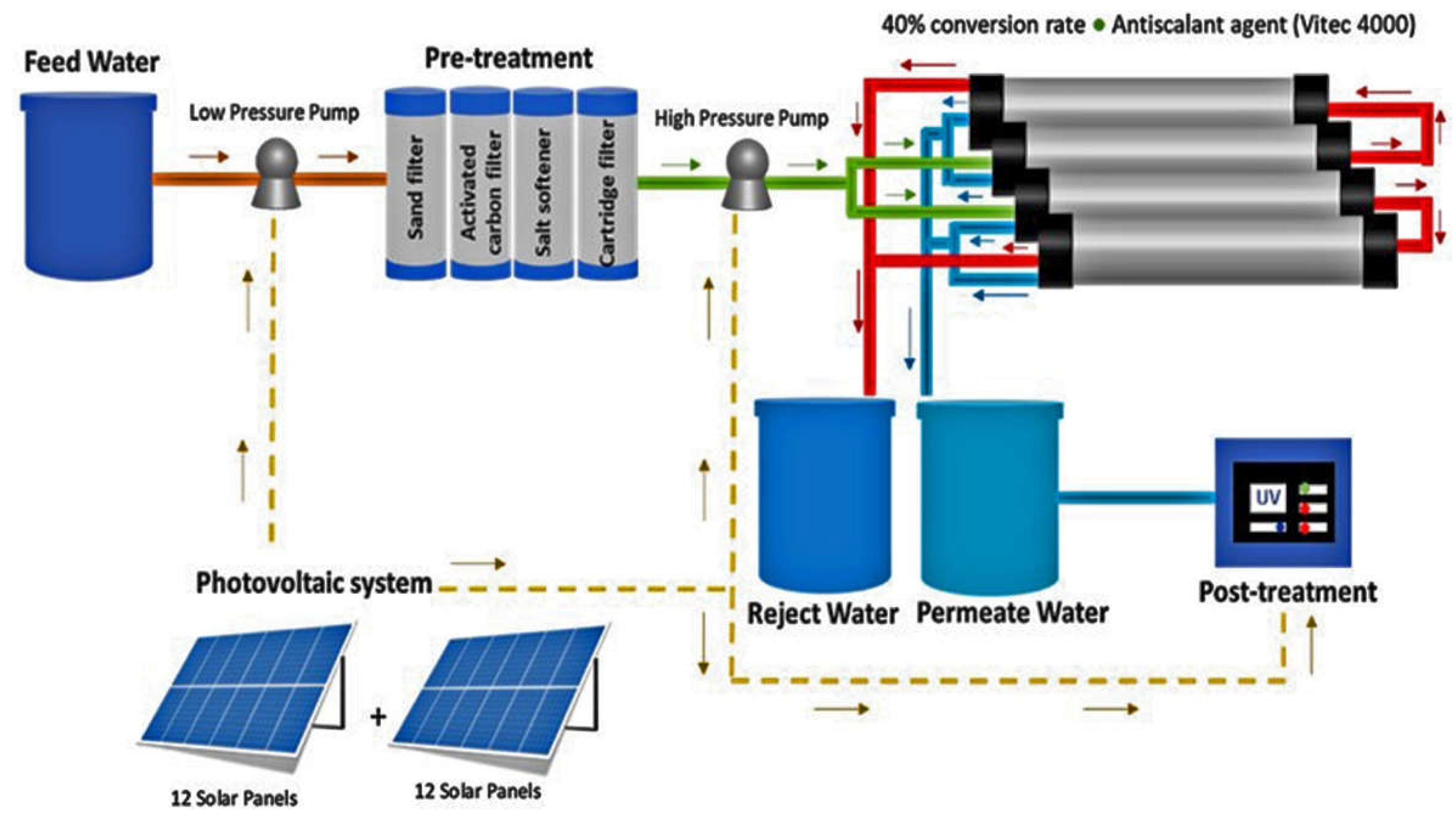
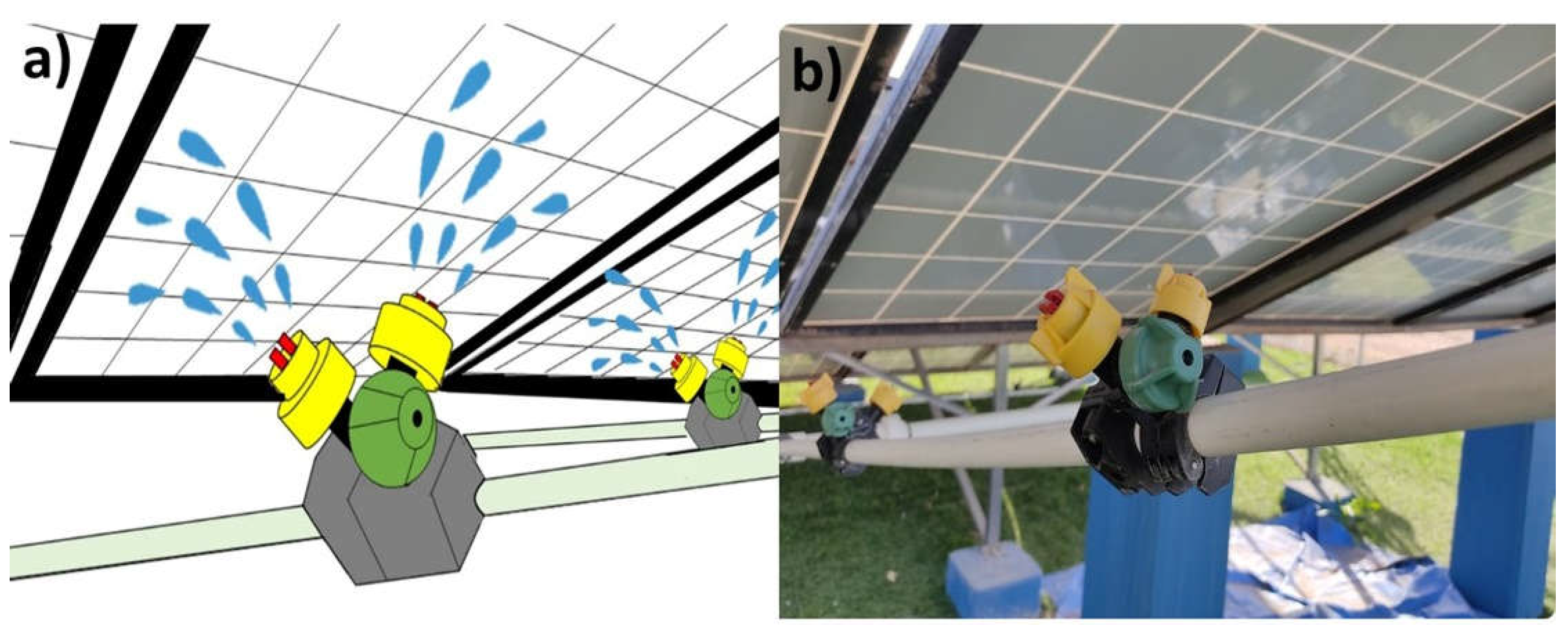

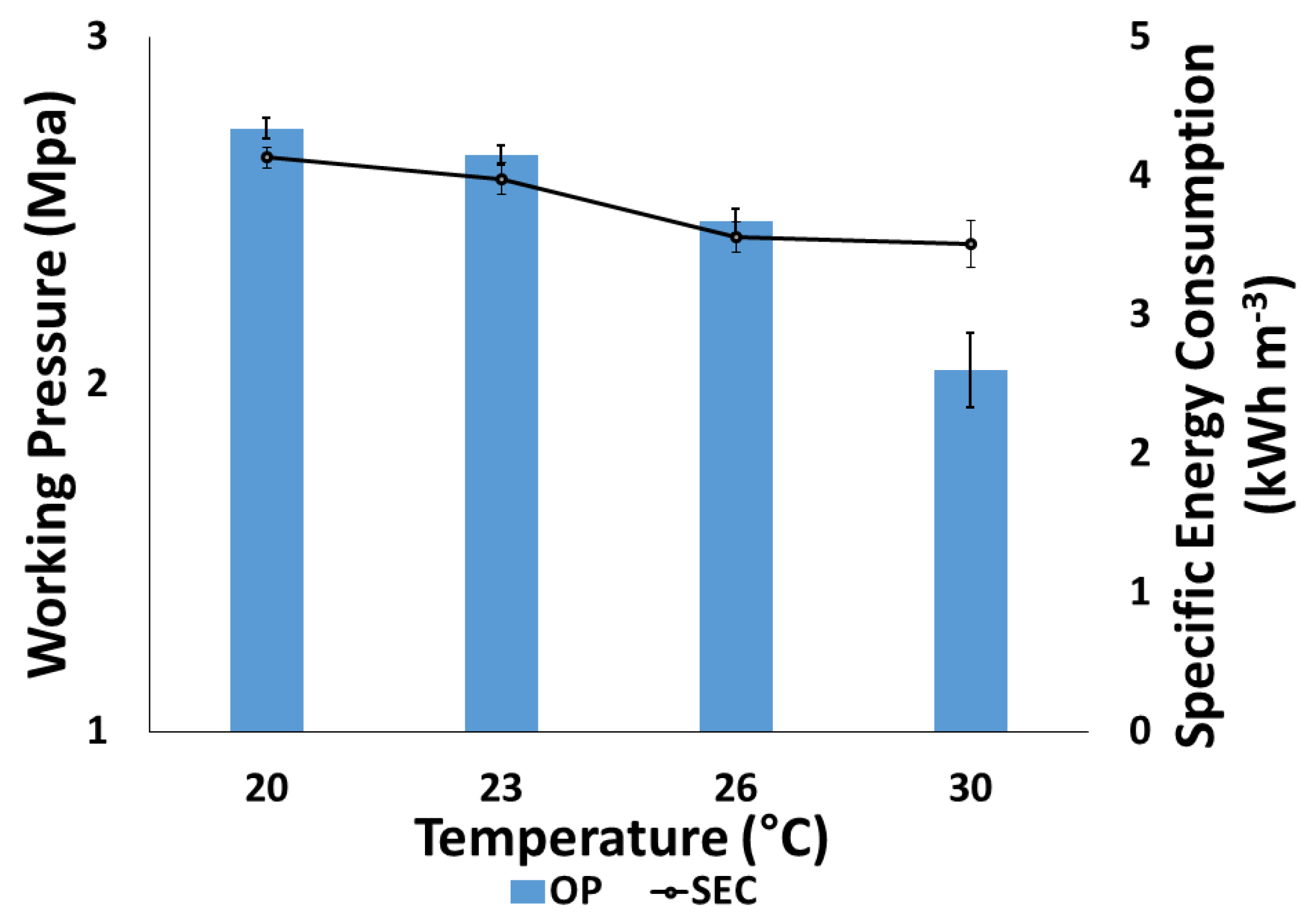

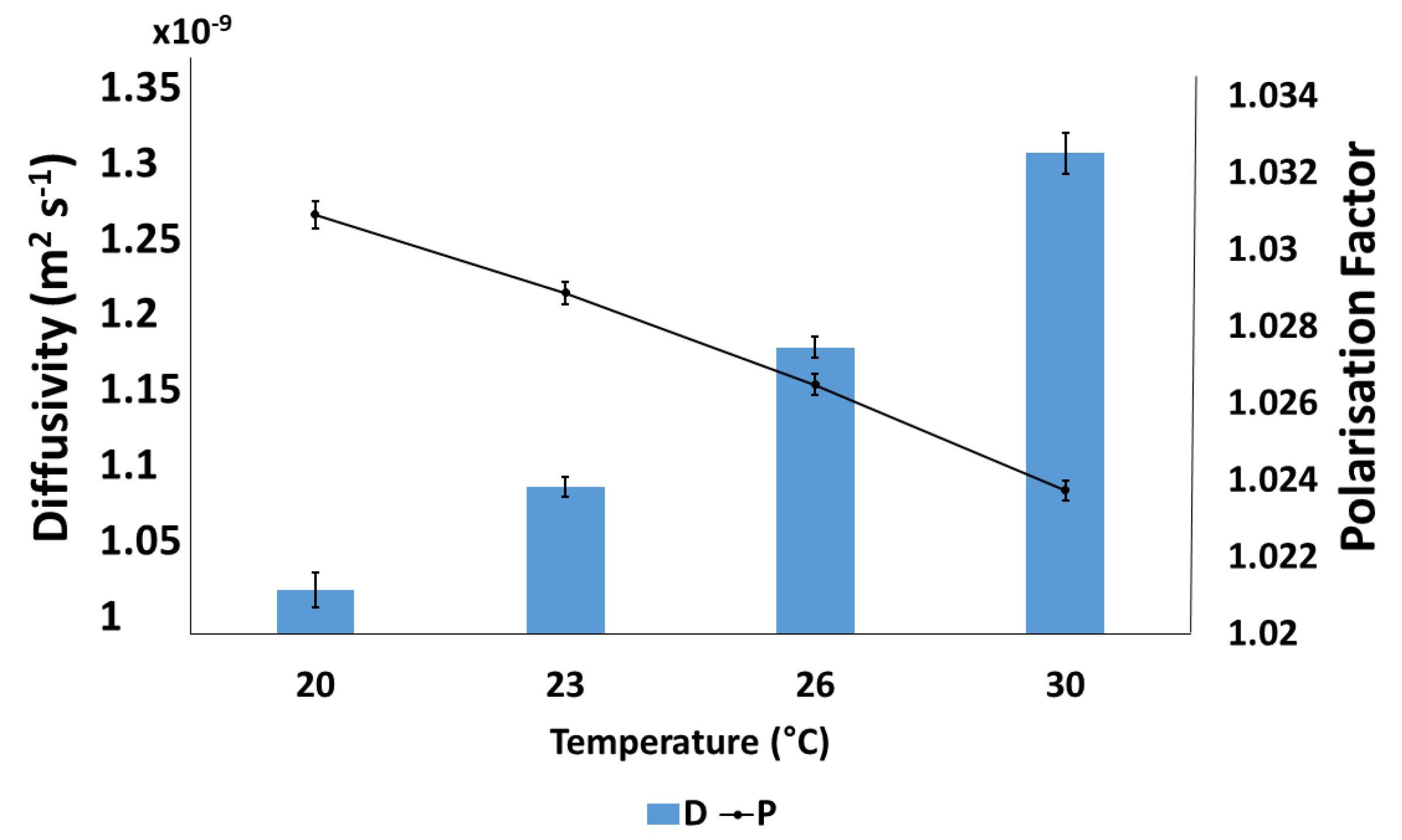

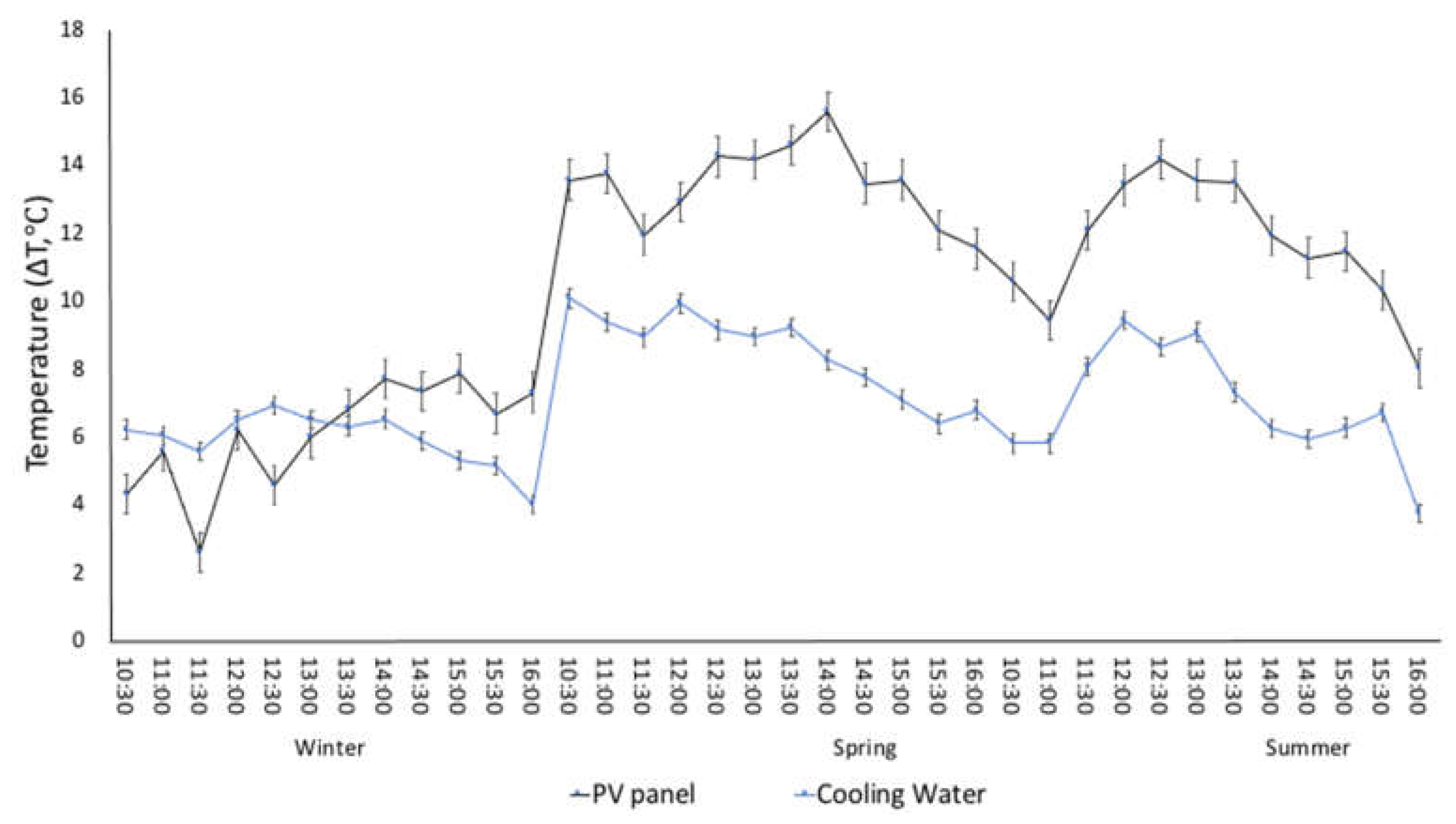
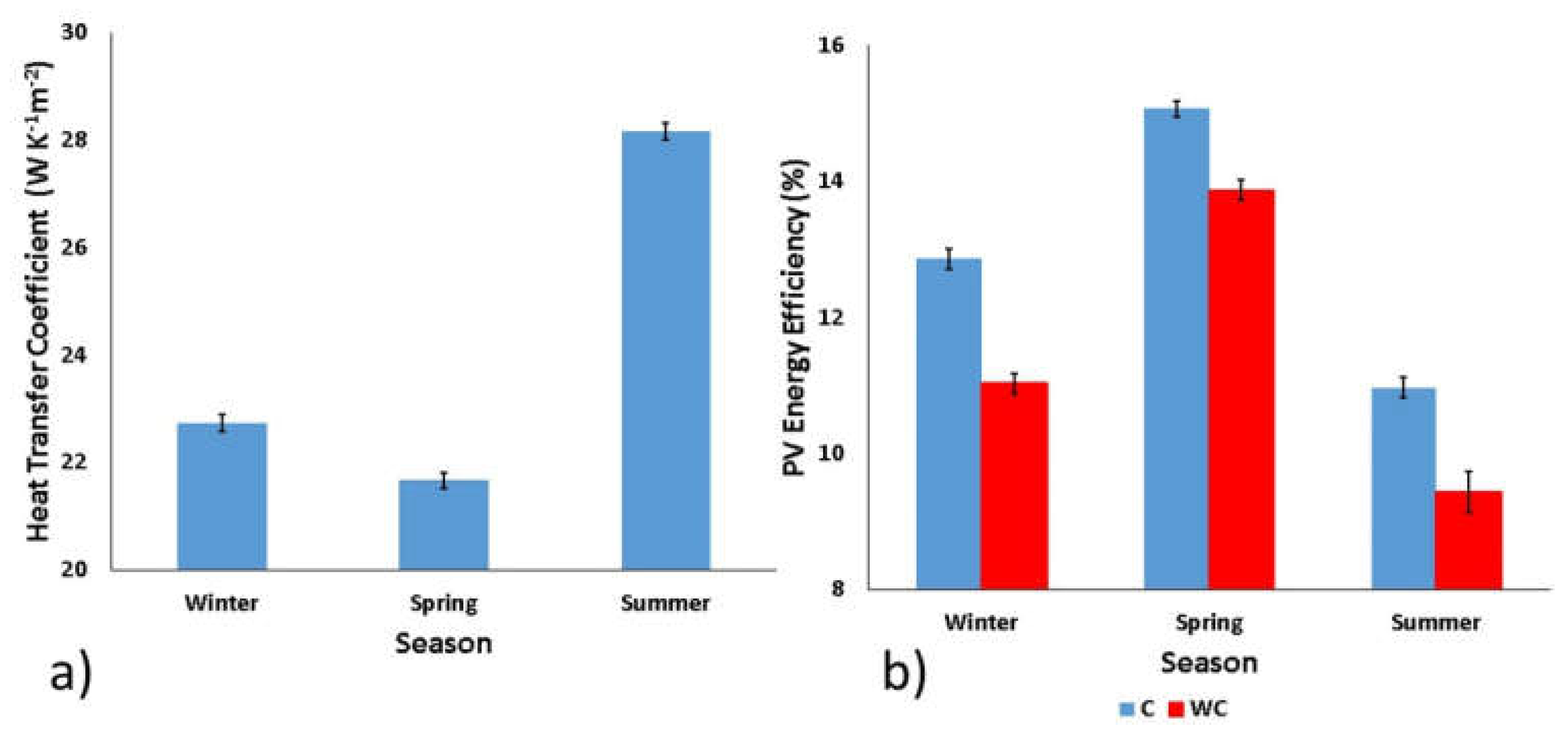

| Parameter | Value |
|---|---|
| Rated power (W) | 240 |
| Rated voltage (V) | 30.4 |
| Rated current (A) | 7.9 |
| Short circuit current (A) | 8.4 |
| Open circuit voltage (V) | 37.7 |
| Efficiency (η) (%) | 14.5 |
| Cells | 60 |
| Effective area (AP) (m−2) | 1.65 |
| Parameter | Value |
|---|---|
| Recommended input power (W) | 190–270 |
| Maximum DC input voltage (V) | 48 |
| Rated output power (W) | 215 |
| Nominal frequency (Hz) | 60 |
| Operating temperature (°C) | −40–65 |
| Efficiency (%) | 96.5 |
| T (°C) | SEC (60%) | c&m (27%) | mp (6.5%) | m (3.6%) | ch (2.9%) | TC | ||
|---|---|---|---|---|---|---|---|---|
| kWh m−3 | USD kWh−1 | USD m−3 | USD m−3 | |||||
| 20 | 4.4 | 1.02 | 0.2244 | 0.101 | 0.024 | 0.013 | 0.011 | 0.374 |
| 23 | 4.3 | 1.02 | 0.2193 | 0.099 | 0.024 | 0.013 | 0.011 | 0.366 |
| 26 | 3.9 | 1.02 | 0.1989 | 0.090 | 0.022 | 0.012 | 0.010 | 0.332 |
| 30 | 3.5 | 1.02 | 0.1785 | 0.080 | 0.019 | 0.011 | 0.009 | 0.298 |
Publisher’s Note: MDPI stays neutral with regard to jurisdictional claims in published maps and institutional affiliations. |
© 2022 by the authors. Licensee MDPI, Basel, Switzerland. This article is an open access article distributed under the terms and conditions of the Creative Commons Attribution (CC BY) license (https://creativecommons.org/licenses/by/4.0/).
Share and Cite
Armendáriz-Ontiveros, M.M.; Dévora-Isiordia, G.E.; Rodríguez-López, J.; Sánchez-Duarte, R.G.; Álvarez-Sánchez, J.; Villegas-Peralta, Y.; Martínez-Macias, M.d.R. Effect of Temperature on Energy Consumption and Polarization in Reverse Osmosis Desalination Using a Spray-Cooled Photovoltaic System. Energies 2022, 15, 7787. https://doi.org/10.3390/en15207787
Armendáriz-Ontiveros MM, Dévora-Isiordia GE, Rodríguez-López J, Sánchez-Duarte RG, Álvarez-Sánchez J, Villegas-Peralta Y, Martínez-Macias MdR. Effect of Temperature on Energy Consumption and Polarization in Reverse Osmosis Desalination Using a Spray-Cooled Photovoltaic System. Energies. 2022; 15(20):7787. https://doi.org/10.3390/en15207787
Chicago/Turabian StyleArmendáriz-Ontiveros, María Magdalena, Germán Eduardo Dévora-Isiordia, Jorge Rodríguez-López, Reyna Guadalupe Sánchez-Duarte, Jesús Álvarez-Sánchez, Yedidia Villegas-Peralta, and María del Rosario Martínez-Macias. 2022. "Effect of Temperature on Energy Consumption and Polarization in Reverse Osmosis Desalination Using a Spray-Cooled Photovoltaic System" Energies 15, no. 20: 7787. https://doi.org/10.3390/en15207787
APA StyleArmendáriz-Ontiveros, M. M., Dévora-Isiordia, G. E., Rodríguez-López, J., Sánchez-Duarte, R. G., Álvarez-Sánchez, J., Villegas-Peralta, Y., & Martínez-Macias, M. d. R. (2022). Effect of Temperature on Energy Consumption and Polarization in Reverse Osmosis Desalination Using a Spray-Cooled Photovoltaic System. Energies, 15(20), 7787. https://doi.org/10.3390/en15207787







